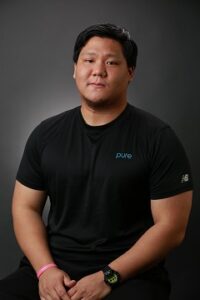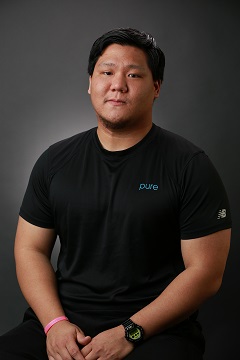The standing cable press is a great way to train the chest because it is less stress on the shoulder joint than the bench press. In addition the standing position forces the body to engage more core so you don’t fall over. It is recommended to use a cable with independent weight stacks to avoid compensation with the stronger arm.
Muscle Emphasis
The primary muscles used to create the movement for the dumbbell press are: Pectoralis Major, Triceps and Anterior Deltoid. The secondary muscles used are Pectoralis Minor, Latissimus Dorsi, Coracobrachialis and Serratus Anterior.
Since you are standing, you will recruit muscles throughout your entire body including: Erector Spinae, Abdominals, Glutes, Hamstrings, Calf and intrinsic foot muscles.
Starting Position
Stand in front of the cable machine with the handles just outside shoulder width. We suggest a neutral (hammer) grip as this allows the shoulder to move more freely. Keep your arms just below 90 degrees and press straight ahead.
Movement
Phase 1 Eccentric: Lower the cables towards the chest to about one inch before touching the chest. Do this in a controlled 2-3 second tempo.
Phase 2 Concentric: Push the cables back to the starting position in a semi explosive tempo. Do not completely lock the elbow just extend it so it is almost locked.
Tips for proper form
- Keep a neutral spine; brace abdominals, glutes, and lower body.
- Place one foot in front of the other.
- Keep the elbows just below 90 degrees and make sure the wrist and elbows line up.
- Push through the palms of the hand.
- Keep the feet planted on the floor.
Common Mistakes
- Shrugging the shoulders.
- Shifting and jerking your body.
- Do not grip much wider than shoulder width, it will put stress on the shoulder.
- Lack of retraction causes the scapula to anteriorly tilt and elevate the humerus. This can lead to an impingement of the subacromial bursa and the supraspinatus.
- Bring the cable handles to roughly where your nipples are. Below the nipples is too low and going near the collar bone is too high.
- Do not let your ego dictate the weight you use because your form will suffer.
Closing Comments
The standing cable press is a great way to work the chest in a way that relates to most sports and daily activities. The standing cable allows the shoulder to move more freely and forces the entire body to stabilize.
Visit our Facebook page to comment on this article or ask questions.
If you’re an NFPT Trainer, join our Facebook community group!
 Kevin Chen is a Certified Personal Trainer through NFPT. He attended Tuckahoe High School where he was the captain of the 2010 State Championship Football Team. After graduating, he went on to attend the University of Hartford where he received his Bachelor of Science degree in Health Science. Kevin spent his summers during college as a volunteer offensive and defensive line coach with the Tuckahoe High School football team. He has attended multiple collegiate football camps and seminars learning from collegiate coaches and trainers from across the country including: Princeton, Lafayette, Stony Brook, Delaware, and Utica.
Kevin Chen is a Certified Personal Trainer through NFPT. He attended Tuckahoe High School where he was the captain of the 2010 State Championship Football Team. After graduating, he went on to attend the University of Hartford where he received his Bachelor of Science degree in Health Science. Kevin spent his summers during college as a volunteer offensive and defensive line coach with the Tuckahoe High School football team. He has attended multiple collegiate football camps and seminars learning from collegiate coaches and trainers from across the country including: Princeton, Lafayette, Stony Brook, Delaware, and Utica.
Kevin’s main focus is to implement strength and resistance training in addition to mobility exercises to improve athletic performance and overall health. Kevin stresses training and strengthening joints at the end range of motion in order to improve power, speed, and mobility. He is also currently training to improve his Olympic lifts as well as researching different techniques used by different Olympic coaches and athletes that will have the best carryover to athletic performance.



